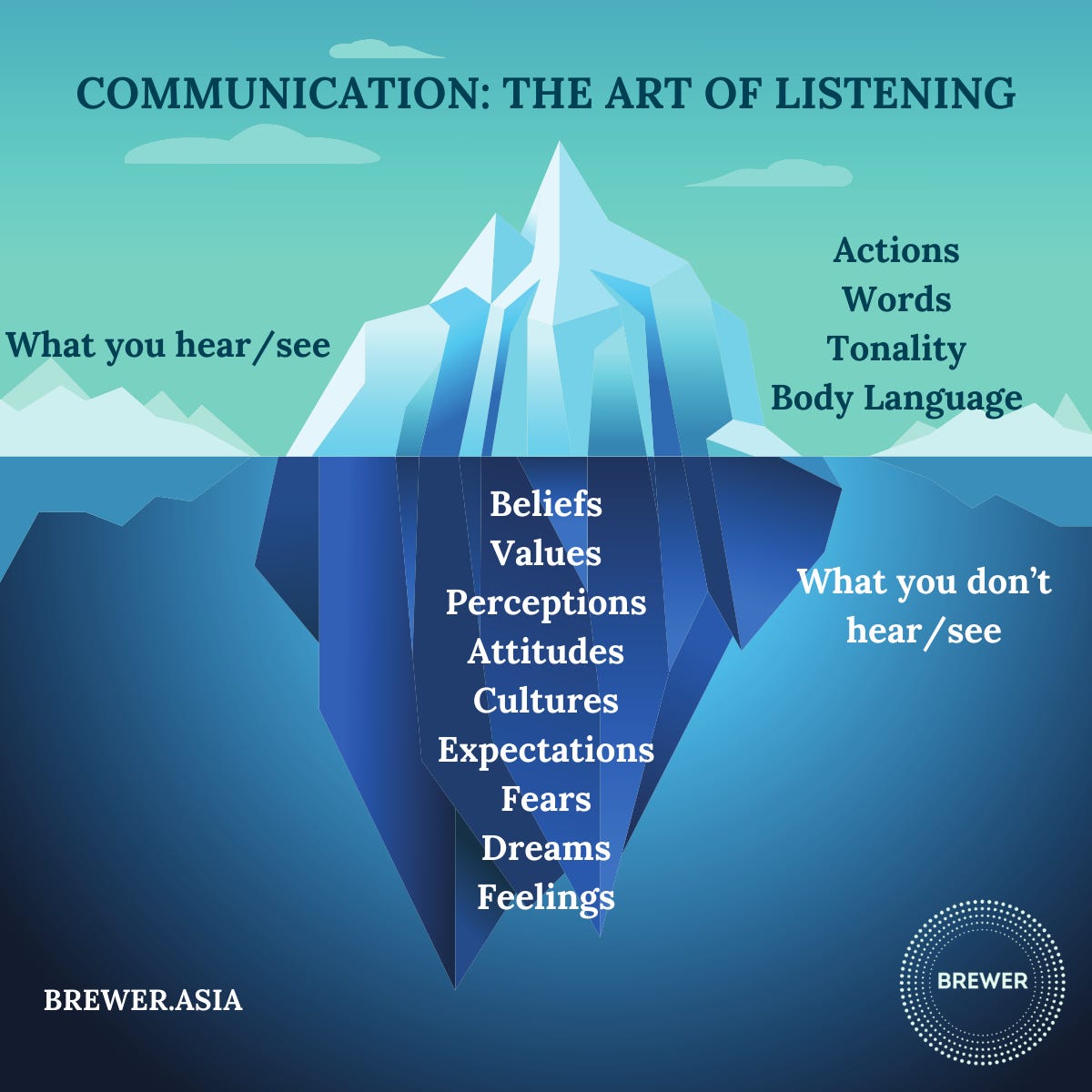How Will You Step Up Your Listening Game In 2025?
An Underrated Leadership Skill That Makes A Difference
Hey there,
How well do you think you can listen?
Pause for a moment and reflect: when you listen, how much do you absorb? Are you truly listening, or just hearing what you want to hear, drawing conclusions? How often do you pay attention to what’s left unsaid? After a conversation, does the other person feel heard? True listening is about understanding what’s beneath the surface—not just the words.
Effective communication starts with listening.
We spend 70% of our time communicating, but we only listen about 45% of the time. The rest? Speaking, writing, reading... and so much more.
Here’s something interesting: we speak at around 150 words per minute, but our brains can process up to 650 words per minute. That means we have plenty of mental capacity to understand more than what’s being said, yet how often do we use that capacity to listen deeply?
The biggest communication problem? We don't listen to understand; we listen to reply. True listening requires full presence—no interruptions, no pre-formulated responses.
Active listening involves giving full attention, asking clarifying questions, and ensuring we understand the message. But to truly listen, we must also be mindfully aware of emotions, body language, and unspoken cues. These often hold as much meaning as the words themselves.
I know firsthand that listening is hard when we’re busy, distracted, or overwhelmed. But that’s exactly why we need to make listening a priority—especially as we approach the new year.
The Iceberg Theory of Listening: What’s Below the Surface?
Think of communication like an iceberg. The words we hear are just the tip—only a small fraction of the message. The real meaning lies beneath the surface: emotions, values, beliefs, unspoken concerns, and motivations.
Active listening helps us catch the words, but mindful listening helps us tune into what's unsaid.
When Cultures Collide
Listening becomes even more complex when we work across cultures. Cultural differences shape how different people communicate.
In American culture, saying "no" is direct, but in Japanese culture, refusal is often more subtle, such as saying "I'll think about it," as Richard Lewis points out in When Cultures Collide. Understanding these nuances is critical to listening effectively and fully grasping the true message.
“Whatever the culture, there’s a tongue in our head. Some use it, some hold it, some bite it. For the French it is a rapier, thrusting in attack; the English, using it defensively, mumble a vague, confusing reply; for Italians and Spaniards it is an instrument of eloquence; Finns and East Asians throw you with constructive silence. Silence is a form of speech, so don’t interrupt it!” Richard Lewis, When Cultures Collide: Leading Across Cultures
Listening to Others
When was the last time you felt heard? And how often do you make others feel that way?
Whether you're engaging with your team, clients, or peers, practicing both active and mindful listening together fosters empathy, collaboration, and trust—key ingredients for healthy relationships.
I’ll be honest, there are times when I get caught up in what I want to say, rather than listening attentively. I’ve missed valuable insights simply because I wasn’t present in the conversation. But learning to listen with my ears, eyes, and heart—mindfully— has been transformative, helping me grow both personally and professionally.
Here's how you can do the same:
Ears: Listen to understand, not just to respond. Ask questions that dig deeper, and make sure you’re fully present—no distractions.
Eyes: Pay attention to non-verbal cues—body language and facial expressions often reveal more than words alone. Make eye contact.
Heart: Listen with empathy. Approach every conversation with genuine curiosity and openness, striving to understand the person’s emotions and perspective.
Listening to Yourself
Just as important as listening to others is listening to yourself. Self-awareness helps you lead with clarity, balance, and authenticity. How often do we ignore the signals from our bodies and minds when it’s time to pause and recharge? Listening to yourself is the first step to better leadership and well-being.
Viktor Axelsen, world badminton champion, recently expressed frustration with the disconnect between athletes' needs and the demands of sports federations. He stressed that athletes must listen to themselves, especially when their well-being is at stake. Similarly, Simone Biles made the courageous decision to step back during the 2020 Tokyo Olympics, prioritising her mental health to return stronger.
Here’s how to start listening to yourself:
Mental Listening: Tune into your thoughts. Research found that about 47% of our waking hours are spent thinking about things unrelated to the present moment, often leading to unhappiness.
“A wandering mind is an unhappy mind”, M.Killingsworth/D.Gilbert
Tip: Take breaks throughout the day to check in with your thoughts. Are they focused, or are you distracted by worries? If your mind is elsewhere, give yourself permission to re-centre and refocus.
Emotional Listening: Recognise your emotions and approach with a sense of curiosity. Ask yourself “What’s causing this emotion and what message is it trying to convey?”
Tip: When stressed or overwhelmed, pause and create space before choosing your response thoughtfully.As Viktor Frankl said, “Between stimulus and response, there is a space. In that space is our power to choose our response. In our response lies our growth and our freedom.”
Physical Listening: Pay attention to your body. Physical symptoms such as fatigue, headaches, or muscle tension are signals we should never ignore. Our bodies often tell us when we’ve reached our limit before our minds can catch up.
Tip: Check in with yourself physically. Are you feeling energised and alert, or are you running on empty? If you’re exhausted or physically drained, it’s time to rest and recharge—your body knows best.
The Listening Challenge: How Well Do You Really Listen?
The 3-Minute Listening Challenge:
For the next three minutes, find someone to listen to (a colleague, friend, or family member). Here’s the challenge:
Listen without interrupting for three minutes.
Observe body language and facial expressions.
After three minutes, summarise what they said.
Reflect on the following:
What did you learn from their words and body language?
What did you notice that you hadn’t expected?
Did you find the exercise easy or difficult?
Key Takeaways & Final Thought:
Active listening is more than hearing words; it’s about understanding emotions, reading between the lines, and engaging all your senses—ears, eyes, and heart.
Mindful listening deepens this by helping us stay fully present and aware of the unspoken cues that shape the conversation. When you listen deeply to yourself and others, you build stronger connections, make better decisions, and unlock your potential.
How will you step up your listening game as we close out the year and head into 2025? Start by reflecting on how deeply you listen today—are you truly present in every conversation? Or challenge yourself by completing the 3-minute Listening Challenge and see what insights you gain.
The power of listening is in you—how will you activate it?
With warm regards,
Serina



